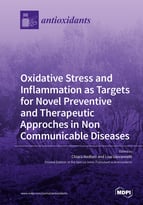Oxidative Stress and Inflammation as Targets for Novel Preventive and Therapeutic Approches in Non Communicable Diseases
A special issue of Antioxidants (ISSN 2076-3921). This special issue belongs to the section "Health Outcomes of Antioxidants and Oxidative Stress".
Deadline for manuscript submissions: closed (31 December 2019) | Viewed by 83793
Special Issue Editors
Interests: oxidative stress; redox signaling; autophagy; heart failure; oleuropein; bioactive natural compounds; polyphenols
Special Issues, Collections and Topics in MDPI journals
Interests: oxidative stress; cell senescence; natural antioxidants; aging; DNA damage
Special Issue Information
Dear Colleagues,
Non-communicable diseases (NCDs) are chronic diseases characterized by being of long duration and very slow progression. NCDs account for approximately 70% of the deaths for cardiovascular diseases, cancer, diabete mellitus, chronic kidney disease, and Alzheimer’s disease. They share common features such as an altered inflammatory status, a redox imbalance, and a compromised autophagy, that participate in the progression of these chronic diseases, and are critical for the development of novel therapeutic strategies. Hence, there is a growing awareness that the modulation of these features through various synthetic pharmacological and natural bioactive compounds (polyphenols, polysaccharides, vitamins, and Omega3) could be employed for novel preventive and therapeuthic approches in NCDs. This Special Issue is dedicated to providing more insight into recent developments in the field. We welcome contributions of both reviews of the literature and original research articles describing the role of oxidative stress and inflammation; their interplay with autophagy; as well as their modulation through signaling pathways and gender response by novel preventive and therapeutic strategies, including drug combinations with natural active compounds, in cell culture systems, preclinical animal models, and human clinical studies.
Prof. Chiara Nediani
Prof. Lisa Giovannelli
Guest Editors
Manuscript Submission Information
Manuscripts should be submitted online at www.mdpi.com by registering and logging in to this website. Once you are registered, click here to go to the submission form. Manuscripts can be submitted until the deadline. All submissions that pass pre-check are peer-reviewed. Accepted papers will be published continuously in the journal (as soon as accepted) and will be listed together on the special issue website. Research articles, review articles as well as short communications are invited. For planned papers, a title and short abstract (about 100 words) can be sent to the Editorial Office for announcement on this website.
Submitted manuscripts should not have been published previously, nor be under consideration for publication elsewhere (except conference proceedings papers). All manuscripts are thoroughly refereed through a single-blind peer-review process. A guide for authors and other relevant information for submission of manuscripts is available on the Instructions for Authors page. Antioxidants is an international peer-reviewed open access monthly journal published by MDPI.
Please visit the Instructions for Authors page before submitting a manuscript. The Article Processing Charge (APC) for publication in this open access journal is 2900 CHF (Swiss Francs). Submitted papers should be well formatted and use good English. Authors may use MDPI's English editing service prior to publication or during author revisions.
Keywords
- Oxidative stress
- Inflammation
- Redox signaling
- Bioactive compounds
- Cancer
- Cardiovascular disease
- Metabolic disease
- Chronic kidney disease
- Aging
- Alzheimer disease
- Gender difference








